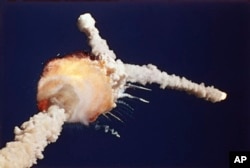Divers looking for the wreckage of a World War II airplane last spring actually found part of the destroyed space shuttle Challenger.
A large piece of the spacecraft was discovered at the bottom of the Atlantic Ocean off the coast of Florida. The site is not far from the U.S. space agency NASA’s Cape Canaveral launch area. NASA confirmed the discovery on November 10.
The piece is from the space shuttle that exploded shortly after liftoff from Cape Canaveral on January 28, 1986. The last time anyone found part of the Challenger was in 1996.
Seven people died when the Challenger exploded. Christa McAuliffe, a school teacher from New Hampshire, was part of the crew. An investigation of the accident found a faulty part in the right rocket booster caused the Challenger explosion.
Michael Ciannilli is a NASA official who confirmed that the newly discovered piece was real.
He told The Associated Press when he first saw video of the space shuttle piece, “my heart skipped a beat … and it brought me right back to 1986 … and what we all went through as a nation.”
Ciannilli said the piece appears to be at least 4.5 meters long and 4.5 meters wide. It could be larger, though, because some of it was covered by sand. He said he thinks the piece may have been from the underside, or belly, of the shuttle.
NASA said it is still thinking about whether to launch a recovery operation to get the shuttle piece or to leave it in the ocean. “We want to make sure … we do the right thing for the legacy of the crew,” Ciannilli said.
About 47 percent of the Challenger shuttle has been recovered since the accident. Much of it is buried in unused sites at Cape Canaveral. Some of it is shown at a NASA visitor’s center, next to a piece from the Columbia space shuttle. Columbia broke apart on its way back to Earth over Texas in 2003, killing all seven astronauts on board.
I’m Dan Friedell.
Dan Friedell adapted this story for VOA Learning English based on a report by the Associated Press.
__________________________________________________________________
Words in This Story
skip –v. a short, quick jump forward
legacy –n. the lasting memory or feeling about someone who lived before
fault –n. a problem or bad part that prevents something from being perfect : a flaw or defect
__________________________________________________________________
We want to hear from you. Do you think NASA will go get the pieces of the found spacecraft?
We have a new comment system. Here is how it works:
- Write your comment in the box.
- Under the box, you can see four images for social media accounts. They are for Disqus, Facebook, Twitter and Google.
- Click on one image and a box appears. Enter the login for your social media account. Or you may create one on the Disqus system. It is the blue circle with “D” on it. It is free.
Each time you return to comment on the Learning English site, you can use your account and see your comments and replies to them. Our comment policy is here.













Forum